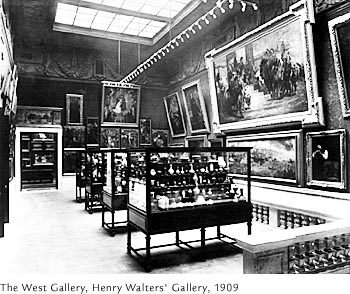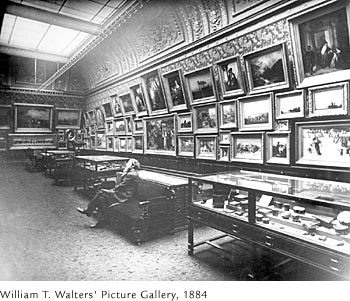History
During the 19th and early 20th centuries, William Thompson Walters and his son, Henry, assembled a diverse range of artworks from around the world—from European master paintings and decorative arts to Greek and Roman antiquities and Far Eastern ceramics. Together, they collected nearly 22,000 works of art, building the foundation for a museum that offers an extraordinary survey of 55 centuries.

William Walters (1819-94)
William Thompson Walters (1819-94), a native of the village of Liverpool in central Pennsylvania, was drawn to Baltimore in 1841. Initially Walters became a grain merchant, but by 1852 he had established a wholesale liquor house that was to become one of the largest firms of its kind anywhere. Six years later, Walters moved to a house on Mount Vernon Place, then the most fashionable residential district in Baltimore.

At about this time, Walters seriously began to collect art, initially patronizing local talents, among them Alfred Jacob Miller (1810-74), who had documented the early fur trade in the West, and the sculptor William H. Rinehart (1825-74).
Unlike most other collectors of the period, William Walters tentatively began to explore contemporary European painting, acquiring The Duel after the Masquerade, by Jean-Leon Gerome, an emerging academic master in Paris.
Prior to the Civil War, Walters had outspokenly defended the right of states to secede from the Union. When the conflict erupted in 1861, he found himself in an untenable position and left the country for Paris with his wife, Ellen, and two children, Henry and Jennie.
With George A. Lucas (1824-1909), a Baltimorean who four years earlier had moved to France, as their guide, William and Ellen Walters toured the major museums and monuments and visited artists' studios, sometimes accompanied by their children. Although his income was limited, Walters patronized contemporary French artists much as he had in Baltimore and New York, commissioning works from Gerome, Honore Daumier, and Antoine-Louis Barye, among others. When William Walters returned to Baltimore at the close of hostilities, his business interests now shifted from liquor to banking and railroads. He continued to expand his art collection, focusing on two fields, contemporary European painting and Asian art. Buying at auctions in New York, and relying on Lucas in Paris to transact purchases abroad, he specialized in French landscape and historical genre paintings. Walters' interests included Japanese lacquers, metalwork, and ceramics; among his Chinese acquisitions were examples of celadons and monochrome porcelains. Henry Walters, by then in his late twenties, had become his father's partner on shopping forays, and in 1889, when William was unable to travel to Paris, he attended exhibitions in his father's place.
As early as 1874 William Walters opened the Mount Vernon Place residence to the public. Every spring, with few exceptions, he continued this civic-minded practice, charging a fee of 50 cents, with the proceeds contributed to charity. Within a decade, when the collection had outgrown the house, he acquired an adjacent property and added a picture gallery.
When William Walters died in 1894, he bequeathed his collection to
his son, Henry, who would follow in his father's footsteps.
copyright © 2001 The Walters Art Museum | All rights reserved